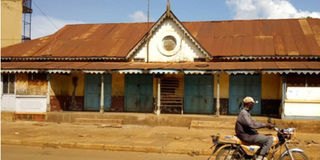Jinja loses its ‘Indian face’ as new buildings take over

Structure. One of the surviving houses built with Indian architectural designs on Main Street in Jinja District. PHOTO BY PHILIP WAFULA
What you need to know:
Exercise. The houses are being remodelled, demolished or replaced by structures such as shopping malls to pave way for development in Jinja Town
Jinja District is home to thousands of Indians with Mr Tamachi Khanani reportedly being the first Indian to settle in 1903.
Mr Khanani is said to have set up a shop in 1903 and 1904 respectively. He would go on to build the first storied building in 1906, paving way for several asbestos-walled houses to sprout in Jinja.
These came to be known as ‘Indian houses’ and were an epitome of their history and culture. However, most, if not all such houses have been remodelled, demolished or replaced by structures such as shopping malls.
The most recent demolition was in 2018 of a house on Naranbhai Road which, until then, had shops and bars at the front and residential units at the back. This site has since been turned into a washing bay.
Madhvani Group House on Jinja Main Street and other buildings on Iganga Road and Gokhale Street have been remodelled into a fusion of European and Indian architecture.
The development on Naranbhai Road, Iganga Road and Jinja Main Street has left some residents fearing that Jinja’s architectural history may be eroded, while others think it is in line with the city status that the municipality is poised to gain on July 1.
Capt David Buyagala, a resident of Mpumudde Village, Mpumudde-Kimaka Division in Jinja municipality, says Jinja Town should have maintained its Indian architecture such as that of Mombasa in Kenya.
Mr Wanambwa Makabuli, a teacher of Luzinga Senior Secondary School in Kamuli District, who resides in Igenge Village, Bugembe Town Council in Jinja District, says there is nothing about Indian architecture to preserve.
“Technology and architectural designs have evolved overtime, so what is there to preserve? And sleeping in a house all walled by asbestos is not trendy in the current sweltering conditions,” he said.
Mr Sanjit Patel, the chairman of Indian association in Jinja, declined to comment on this matter, saying: “I don’t know much about Indian architectural history.”
Efforts to get a comment from Mr Charles Nampendo, the Jinja municipal engineer, were futile.


